Change Page: 123 > | Showing page 1 of 3, messages 1 to 20 of 42 - powered by ASPPlayground.NET Forum Trial Version
Author
|
Message

|
 Breeding Journal, Species: Nerita tessellata
Tuesday, July 9, 2013 7:56 PM
Breeding Journal, Species: Nerita tessellata
Tuesday, July 9, 2013 7:56 PM
( permalink)
Breeding Journal DataSheet
This first post should be updated regularly to include new information as events take place or changes are made to your system General Species: Nerita tessellata Social Structure: 5 Size of Individuals: ~1-1.5" Age of Individuals: Unknown Date added to Tank: About 3 months about Broodstock Tank Details Size of Tank: 150g reef Substrate Details: Deep Sand Bed Filtration Details: 40 gallon Biological Water Changes: Annually Water Temperature: 78°F Lighting: LED's Lighting Cycle: 16 on, 8 off Other Tank Inhabitants: Various Anthias and wrasses, A pair of purple firefish, Bicolor Blenny Broodstock Feeding Details Food Types: Algae off of the wall Feeding Schedule: All the time Spawning Details Date of First Spawn: July 9, 2013 Spawn Time of Day: From 9:00 pm to 4:00 am MST Dates of Consecutive Spawns: Courtship Details: Unknown/None Seen Egg Size: Very Small, <1 mm Egg Color: White Egg Count: +1000 Hatch Details Hatch Date: July 11, 2013 Hatch Time of Day: Unknown, Most likely at night # Days after Spawn: 2 Larvae Description: Veliger, small, has an extended mouth with "eyelashes" for feeding, and a few whirls starting out for shell developement Larval Tank Details Temperature: Unknown, most likely around ~70 - 75 Size of Larval Tank: Waterbottle Substrate Details: None Other Tank Decor: None Filtration Details: None Lighting: Ambient, Sun Lighting Cycle: Ambient Water Changes: None Larval Feeding Details Food Types: Isochrysis galbana, Tetraselmis chuii Feeding Schedule: all the time Metamorphosis/Settlement Date of Settlement Start: Days after Hatch: Date of Settlement End: Description of Fry:
Grow-Out Tank Details Temperature: Size of Grow-Out Tank: Substrate Details: Other Tank Decor: Filtration Details: Lighting: Lighting Cycle: Water Changes: Size at Transfer: Age at Transfer: Grow-Out Feeding Details Food Types: Feeding Schedule: Additional Information (No Pictures or Videos in the Section Please) Miscellaneous Information: You will be required to provide photographic evidence in this thread of each event submitted for the MBI Program.
If your thread does not contain these photos the MBI Committee will not be able to approve your reports.
<message edited by Amphispur on Monday, December 16, 2013 11:15 PM>
|
|
|
 Re: Breeding Journal, Species: Nerita tessellata
Tuesday, July 9, 2013 7:57 PM
Re: Breeding Journal, Species: Nerita tessellata
Tuesday, July 9, 2013 7:57 PM
( permalink)
Ok so I am starting this journal just in case, and I will update it when more info is available. Right now I have a possible fry of this and I will attempt to raise it through adulthood, which I have read is around 4 months.
|
|
|
 Re: Breeding Journal, Species: Nerita tessellata
Sunday, July 14, 2013 4:19 PM
Re: Breeding Journal, Species: Nerita tessellata
Sunday, July 14, 2013 4:19 PM
( permalink)
Many thanks to tal, after the conference I went to the "party" he was having at his house the day afterwards. While I was there he looked at my "fry" (we had no idea what they were) and they were babies! So I will get photos up ASAP. The eggs were most likely laid sometime between the night of the 11th to the morning of the 12th. It took the eggs 2-3 days to hatch. Now I tried various methods back at my home for hatching these eggs, removing them, letting them stay, etc. With these eggs, right before I left my home for the conference I gathered 4 spawns off of my tank wall and stuck them in a water bottle. They got little to no sunlight - as little as I could while in a 2 day car drive- so that I could limit the algae growth. Also I have no fresh RO/DI on me this trip so whatever evaporates stays evaporated until I get back. After their hatch, there was close to 1000 of these guys swimming in the water, apperantly they have a pelagic phase. Now that they have hatched I will still be keeping them in the water bottle until I get home, but I am leaving it in the window for algae growth for 15 minutes and 30 minute breaks in between. This is only an experimental batch and I will be trying these guys more thoroughly when I get home and have access to algae. I will be attempting to grow them on live Isocrysis galbana algae.
<message edited by Amphispur on Monday, July 15, 2013 2:17 PM>
|
|
|
 Re: Breeding Journal, Species: Nerita tessellata
Sunday, July 14, 2013 4:21 PM
Re: Breeding Journal, Species: Nerita tessellata
Sunday, July 14, 2013 4:21 PM
( permalink)
This pelagic phase, in which they have, lasts until they hit meta, or other research SUGGESTS that, then they will become benthic and stay on the sand bottom. I plan on once they are benthic, if I can get this batch to last that long at least, I will add a 2" or so sand bed rinsed from my 150g display tank in which they came from.
<message edited by Amphispur on Monday, July 15, 2013 10:46 PM>
|
|
|
 Re: Breeding Journal, Species: Nerita tessellata
Sunday, July 14, 2013 4:31 PM
Re: Breeding Journal, Species: Nerita tessellata
Sunday, July 14, 2013 4:31 PM
( permalink)
Also, as far as detaching the eggs from the glass, I used a metal algae scraper as scrapped them off of the wall. Yes, some broke off and apart but I managed to keep around 80 to 90% of the clutches. Then I moved them to the bottle immediately afterwards via my hands. The fry are extremely small, around the size of an adult Apocyclops panamensis if not a little bit smaller.
<message edited by Amphispur on Monday, July 15, 2013 10:46 PM>
|
|
|
 Re: Breeding Journal, Species: Nerita tessellata
Sunday, July 14, 2013 5:15 PM
Re: Breeding Journal, Species: Nerita tessellata
Sunday, July 14, 2013 5:15 PM
( permalink)
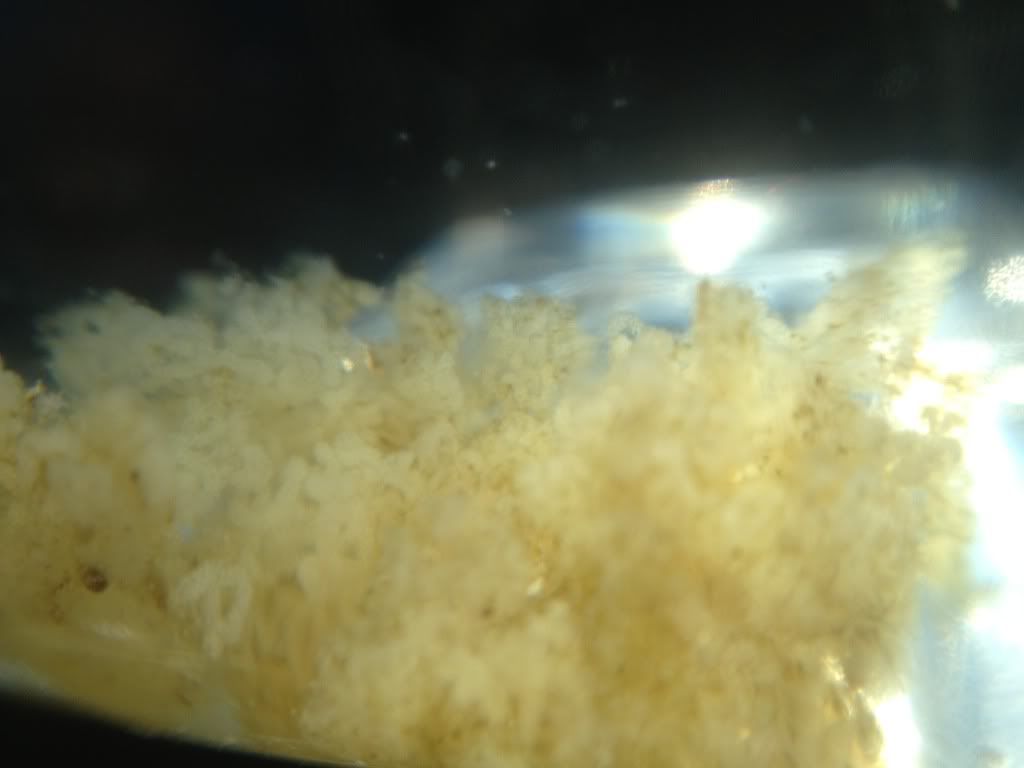 There is a photo of the egg mass. So I have a theory about their egg masses. One thing I noticed is when they are hatched, they are all nice and "white," unlike in the photo, where there was spots of black-coloration on the eggs. I theorize that these "black-colorations" are actually eggs that have hatched. They did not show up until the eggs ha hatched and the larvae were released into the water.
|
|
|
 Re: Breeding Journal, Species: Nerita tessellata
Sunday, July 14, 2013 7:43 PM
Re: Breeding Journal, Species: Nerita tessellata
Sunday, July 14, 2013 7:43 PM
( permalink)
Here is a photo that I hope will help understand this more, the eggs withing the black circles are eggs that are hatched, and the red circle are eggs that have not hatched yet: 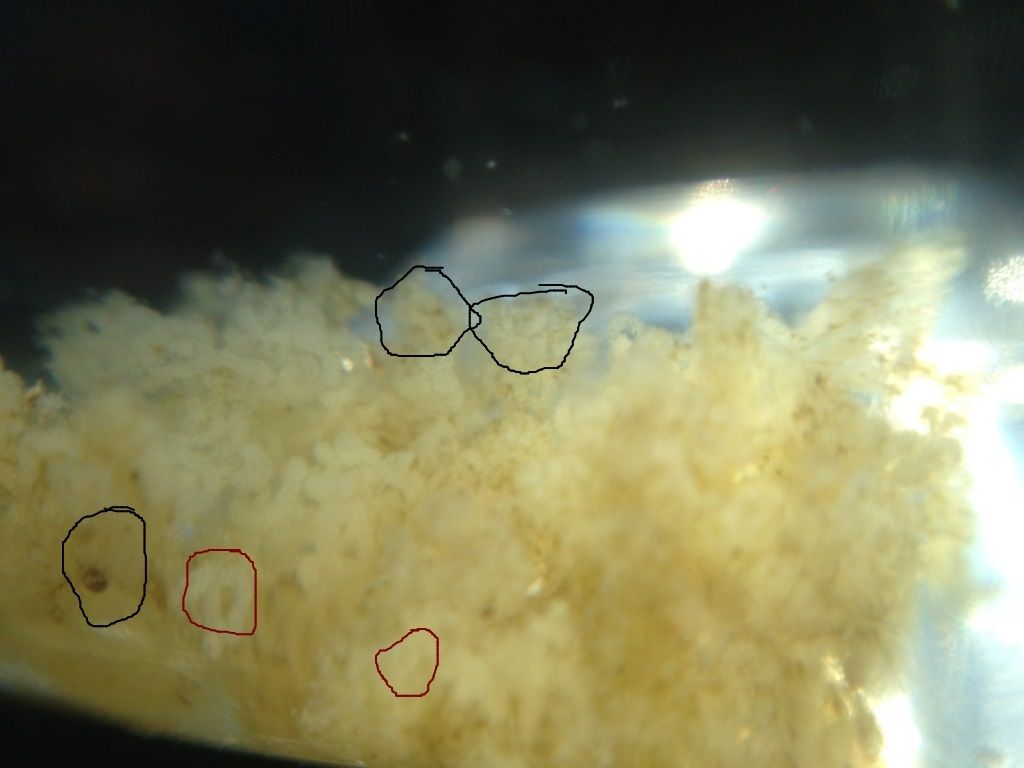
|
|
|
 Re: Breeding Journal, Species: Nerita tessellata
Monday, July 15, 2013 11:51 AM
Re: Breeding Journal, Species: Nerita tessellata
Monday, July 15, 2013 11:51 AM
( permalink)
As far as what I have read, not too much is known about its breeding habits and I have not seen any information about larvae of this exact species, but I have found some information about other nerite species. The only "true" and helpful site I could find was in German, and that site didn't have the exact species I am working with. But what it did tell me was that development could take anywhere from 3 weeks to 6 months depending on the outside conditions of the container it is. Also it says that "A breeding in the aquarium was not previously possible." Species first?? I am yet to find ANY information that tells of this being bred in captivity before. Here is a photo of some larvae of Neritina (Nerite) turrita, 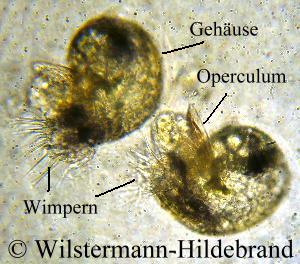 - http://www.heimbiotop.de/Neritina_turrita_Veliger2_beschr.jpg The website is in German so I translated the image, the "Wimpern" are the "eyelashes," the "Gehäuse" is the "housing," and I believe this means the outside shell and its' strength to allow support and safety for the larvae, and an operculum is "a horny plate that closes the opening of the shell when the animal is retracted.". It seems that the life cycle of this animal is somewhat similar to that of a Zebra Mussell, Dreissena polymorpha. Also, the term for the larvae of gastropods are called veliger. There are a range of veliger stages that occur while the gastropod is growing, and in these it slowly starts to have a similar shell shape to the adult gastropod. - http://el.erdc.usace.army.mil/zebra/zmis/zmishelp4/veliger_stages.htm
<message edited by Amphispur on Monday, August 5, 2013 11:46 PM>
|
|
|
 Re: Breeding Journal, Species: Nerita tessellata
Wednesday, July 17, 2013 3:51 PM
Re: Breeding Journal, Species: Nerita tessellata
Wednesday, July 17, 2013 3:51 PM
( permalink)
It's day 5 since the eggs have hatched and there was a MAJOR die off, only about 25-30% were alive this morning. I get back home around 6ish tonight so I will take the alive larvae and put them into a cleaner container (move them from this container, rinse it, then put new saltwater in it and the larvae back in it.) I will also be looking at the "dead" one too. There is a small possibility that these guys have actually hit their demersal stage and be going into meta. Another observation on the leftover larvae was that they were bigger than when they were hatched and from yesterday's observation as well. They have gone from less than a millimeter to around, if not a little less than, a millimeter.
|
|
|
 Re: Breeding Journal, Species: Nerita tessellata
Wednesday, July 17, 2013 4:32 PM
Re: Breeding Journal, Species: Nerita tessellata
Wednesday, July 17, 2013 4:32 PM
( permalink)
Tell us more about your tank, please. How do you move the water? Do you add phyto? Can you share a picture?
The fact that it looks like they settled for you after only a few days in the eggs (although removal from the glass may have changed when they hatched?) and what is, presumably, a longish pelagic phase is rather remarkable. Congratulations!
--Andy, the bucket man. "Not to know the mandolin is to argue oneself unknown...." --Clara Lanza, 1886
|
|
|
 Re: Breeding Journal, Species: Nerita tessellata
Wednesday, July 17, 2013 4:46 PM
Re: Breeding Journal, Species: Nerita tessellata
Wednesday, July 17, 2013 4:46 PM
( permalink)
Thank you Andy! Now I'm for certain that they have hit meta, since it's a 50/50 chance ok if they are in meta or dead, but they are definitly growing within the bottle in their pelagic phase. So first I'll talk about the bottle, basicay there was nothing added, algae or rodi water, an this is somewhat of a "control." Here is a photo of the bottle: 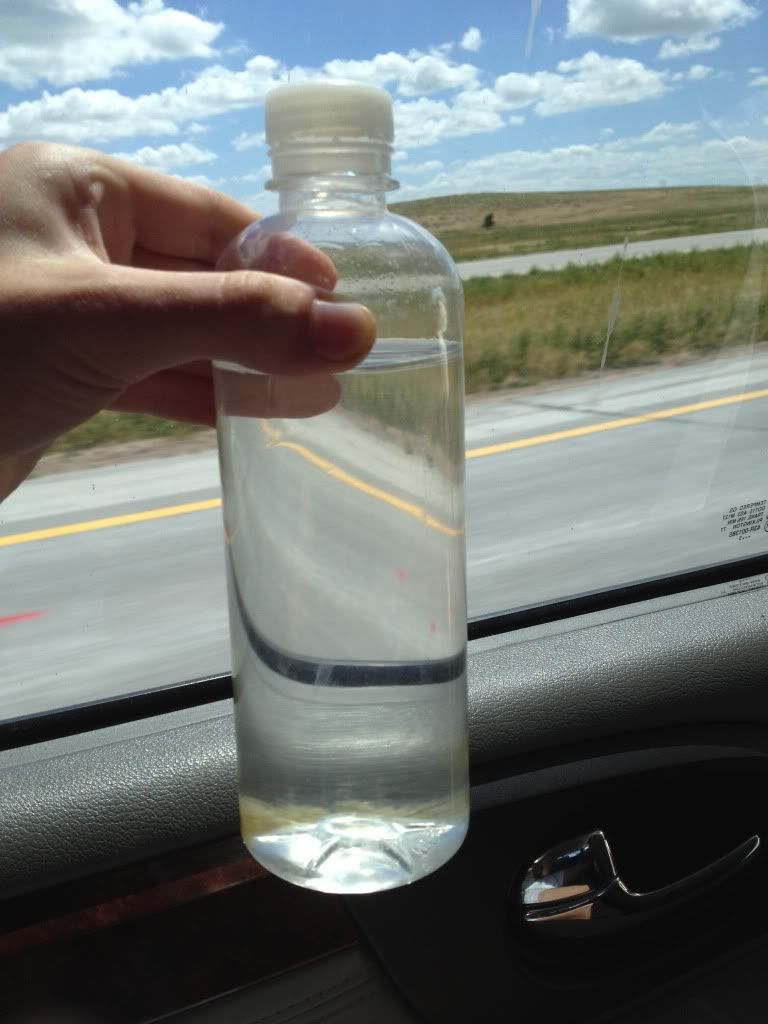 As far as the tank the Adults are living in, the flow is a circular flow with a pump on the left side and on the right side, the pump on the left is bigger (I have no idea on the flow rates this is memory until tonight), algae in the tank, I'm not sure on the exact species, but when I started the system up I used live Isocrysis galbana, tetraselmis, and nanochloropsis. Here is a photo of that tank: 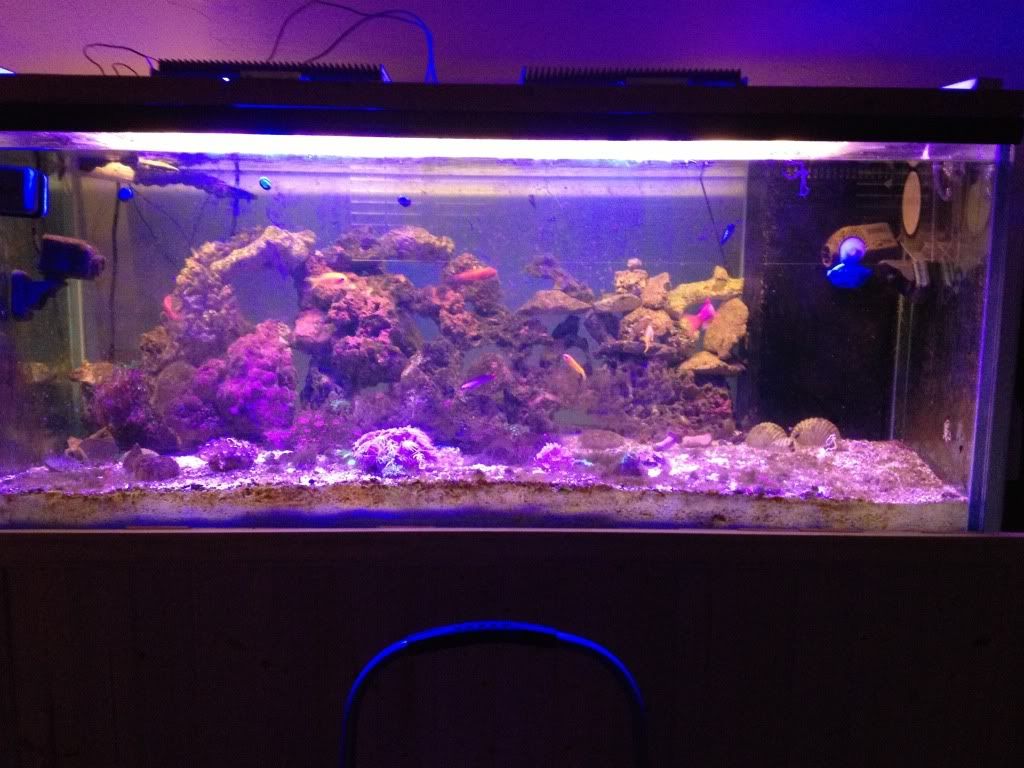
|
|
|
 Re: Breeding Journal, Species: Nerita tessellata
Wednesday, July 17, 2013 4:47 PM
Re: Breeding Journal, Species: Nerita tessellata
Wednesday, July 17, 2013 4:47 PM
( permalink)
Sorry, that first sentence should say NOT certain if they have hit meta or not
|
|
|
 Re: Breeding Journal, Species: Nerita tessellata
Wednesday, July 17, 2013 9:23 PM
Re: Breeding Journal, Species: Nerita tessellata
Wednesday, July 17, 2013 9:23 PM
( permalink)
Well, _if_ they are alive in there and have settled then we'll know that they have a non-feeding (and probably short) pelagic phase. That would explain why you were successful. It would mean that they likely settle awfully small, too, given how quickly they hatched.
It would likely need to be a short pelagic phase because of the powerheads, so that would make sense.
You should move the photos of the adult and juvenile over here when you get the chance.
--Andy, the bucket man. "Not to know the mandolin is to argue oneself unknown...." --Clara Lanza, 1886
|
|
|
 Re: Breeding Journal, Species: Nerita tessellata
Wednesday, July 17, 2013 9:25 PM
Re: Breeding Journal, Species: Nerita tessellata
Wednesday, July 17, 2013 9:25 PM
( permalink)
And I just want to go ahead and add, a short pelagic phase makes sense, too, from the way the adult's shell is formed.
--Andy, the bucket man. "Not to know the mandolin is to argue oneself unknown...." --Clara Lanza, 1886
|
|
|
 Re: Breeding Journal, Species: Nerita tessellata
Wednesday, July 17, 2013 9:49 PM
Re: Breeding Journal, Species: Nerita tessellata
Wednesday, July 17, 2013 9:49 PM
( permalink)
Well Andy, not out of the woods yet  still in their larval stage, just got home and looked under the microscope. Still very much alive though which is a relief. What's not a relief is that they were invaded! Saw a rotifer or something in it as well... Hopefully all will go well. So now, I will be siphoning up the larvae and doing my "remix" into a fresh new water bottle with new saltwater.
|
|
|
 Re: Breeding Journal, Species: Nerita tessellata
Wednesday, July 17, 2013 10:24 PM
Re: Breeding Journal, Species: Nerita tessellata
Wednesday, July 17, 2013 10:24 PM
( permalink)
Ok so here are some videos and pics of the fry. The first two videos are one's that Tal took at his place (Thanks Tal!) And the third is mine. That video and the picture were taken 20 minutes ago! 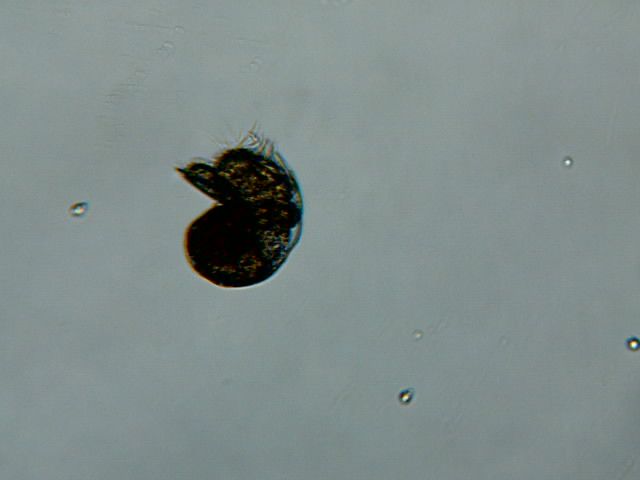
|
|
|
 Re: Breeding Journal, Species: Nerita tessellata
Wednesday, July 17, 2013 10:29 PM
Re: Breeding Journal, Species: Nerita tessellata
Wednesday, July 17, 2013 10:29 PM
( permalink)
|
|
|
 Re: Breeding Journal, Species: Nerita tessellata
Wednesday, July 17, 2013 10:29 PM
Re: Breeding Journal, Species: Nerita tessellata
Wednesday, July 17, 2013 10:29 PM
( permalink)
|
|
|
 Re: Breeding Journal, Species: Nerita tessellata
Wednesday, July 17, 2013 10:58 PM
Re: Breeding Journal, Species: Nerita tessellata
Wednesday, July 17, 2013 10:58 PM
( permalink)
Ok they are in the same bottle now, just with fresher water and some live Isocrysis.
|
|
|
 Re: Breeding Journal, Species: Nerita tessellata
Saturday, August 3, 2013 7:57 PM
Re: Breeding Journal, Species: Nerita tessellata
Saturday, August 3, 2013 7:57 PM
( permalink)
How are these guys doing?
--Andy, the bucket man. "Not to know the mandolin is to argue oneself unknown...." --Clara Lanza, 1886
|
|
|
|